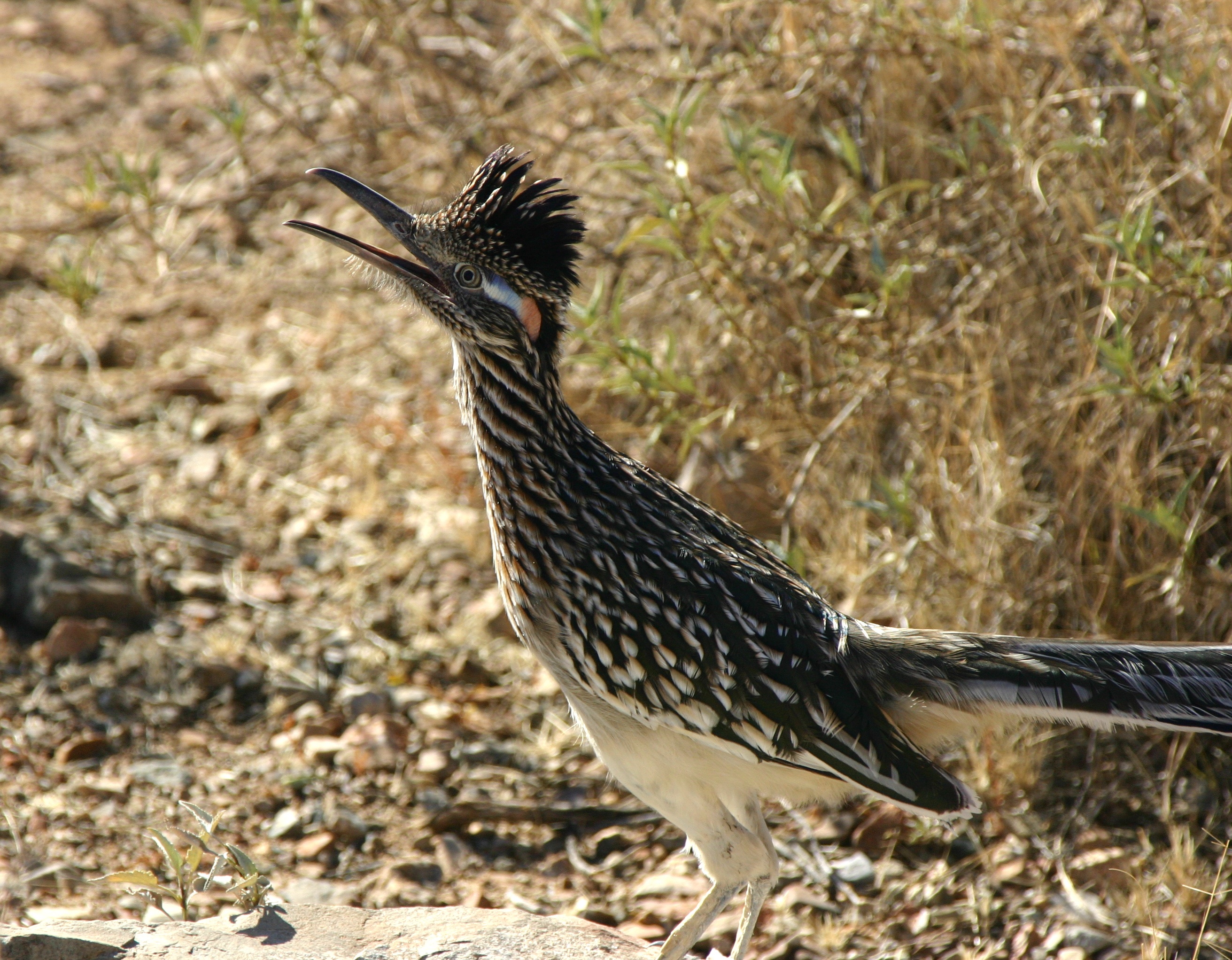- Geococcyx
regnum =Animal ia
phylum = Chordata
classis = Aves
ordo =Cuculiformes
familia =Cuculidae
subfamilia =Neomorphinae
genus = "Geococcyx"
genus_authority = Wagler,1831
subdivision_ranks = Species
subdivision = "G. californianus" "G. velox"The roadrunners are two species of
bird in the genus "Geococcyx" of thecuckoo family, Cuculidae, native to North andCentral America . These two species are the ground foraging cuckoos.*
Greater Roadrunner , "Geococcyx californianus" (southwesternUnited States )
** Conkling's Roadrunner, "Geococcyx californianus conklingi" - prehistoric
*Lesser Roadrunner , "Geococcyx velox" (Mexico and Central America)Morphology
Roadrunner species generally range in size from convert|18|in|cm to convert|24|in|cm from tail to beak. The roadrunner is a large, slender, black-brown and white streaked ground bird with a distinctive head crest. It has long legs, strong feet, and an oversized dark bill. The tail is broad with white tips on the three outer tail feathers. The bird has a blank patch of skin behind each eye; this patch is is shaded blue proximally to red distally. The lesser roadrunner is slightly smaller, not as streaky, and has a smaller bill. The roadrunner is large and long-legged, with a thick, long black beak and a long dark tail. The bird is terrestrial; although capable of flight, it spends most of its time on the ground. During flight, the wings are short and rounded and reveal a white crescent in the primary feathers. Roadrunners and other members of the cuckoo family have zygodactyl feet (two toes in front and two toes in back). Roadrunners can run at speeds of up to 15 miles per hour (24 km/h) and generally prefer sprinting to flying. Roadrunners will fly to escape faster moving
predators such ascoyote s.Vocalization
The roadrunner has a dove-like "coo" that is slow and descending.
Its distinct mating call is a very domineering tone, descending from a high pitch.
It also makes a rapid clattering sound with its mandibles.Ogg vorbis file of clattering sound made with mandibles.
* [http://www.birds.cornell.edu/AllAboutBirds/BirdGuide/Greater_Roadrunner.html#fig1 Link to a greater roadrunner call]Geographic range
The roadrunner is an inhabitant of the
deserts of the SouthwesternUnited States ,Mexico , andCentral America .
*Habitat: Roadrunners live in arid lowland or montane scrub and are often widely dispersed in the dry open country with scattered brush.
*Migration: Roadrunners are non-migratory birds that reside in their breeding area all year.
* [http://content.ornith.cornell.edu/UEWebApp/images/greater-roadrunner-map_s.gifLink to a distribution map of the Greater Roadrunner from the Cornell lab of Ornithology]Food and foraging habits
Roadrunners are
omnivores and are opportunistic. Their diet normally consist ofinsects (such as grasshoppers, crickets, caterpillars, and beetles), smallreptiles (such as lizards and snakes, including rattlesnakes), rodents and small mammals,tarantula s,scorpion s,centipede s,spider s, small birds, eggs, nestlings, and fruits and seeds like prickly pearcactus and sumac. The lesser roadrunner eats mainly insects. Roadrunners forage on the ground and, when hunting, usually run after prey from under cover. They may leap to catch insects, and commonly batter certain prey, such as snakes, against the ground."Geococcyx" is the only real predator of the tarantula hawk wasps.
Behavior and breeding
Roadrunners are commonly solitary birds or live in pairs. They are monogamous and a pair may mate for life. Pairs may hold a territory all year. During the courtship display, the male bows, alternately lifting and dropping his wings and spreading his tail. He parades in front of the female with his head high and his tail and wings drooped. It has also been documented that the male may bring an offering of food to the female.
*Nest: Roadrunners nest are often on a platform nest composed of sticks (nest may sometimes contain leaves, snakeskins, or dung). The nest are commonly placed in a low tree, bush, or cactus.
*Clutch: Hatching is asynchronous and average a 2-6 egg clutch (the Lesser Roadrunners clutch size is typically smaller). Eggs are generally a white color.
*Parental care and sizes: Roadrunners havebi-parental care . Both sexes incubate the nest and feed the hatchlings, but males incubate the nest at night. For the first one to two weeks after the young hatch, one parent always remains at the nest. After the hatchlings are two to three weeks old they leave and never return to the nest. For a few days thereafter, the parents and young forage together. It is said that some road runners can be up to 3.2 feet tall although most range from 1-2.6 feet tall.
*Reproductive Season: spring to mid-summer depending upon species and geographic location.
*Links with images of roadrunner nestlings and nest:
**http://www.miriameaglemon.com/Trip%20Photos/Arizona%202004/Saguar6.jpg
**http://mirror-pole.com/collpage/roadrunr/rr_erny1.jpgThermoregulation
During the cold desert night, the roadrunner lowers its body temperature slightly, going into a slight
torpor to conserve energy. To warm himself during the day, the roadrunner exposes dark patches of skin on his back to the sun.References
* "The Illustrated Encyclopedia of BIRDS" edited by Dr. Christopher M. Perrins ISBN 0-13-083635-4
*"Grzimek's Animal Life Encyclopedia" edited by Michael Hutchins ISBN 0-7876-5785-9
*"Handbook of Birds of the World" edited by Josep del Hoyo et al. ISBN 84-87334-22-9
*"Smithsonian: Birds of North America" by Fred J. Alsop III ISBN 0-7894-8001-8
* Harrison, George. 2005. Comical Cuckoo. Birder's World, 19:56-58.
* Meinzer, Wyman. 1993. Beep! Beep! Better pull over, folks-it's the roadrunner. Smithsonian, 23: 58External links
* [http://www.naturefootage.com/stockfootage/Roadrunner naturefootage.com] has video clips of roadrunners in action.
Wikimedia Foundation. 2010.

